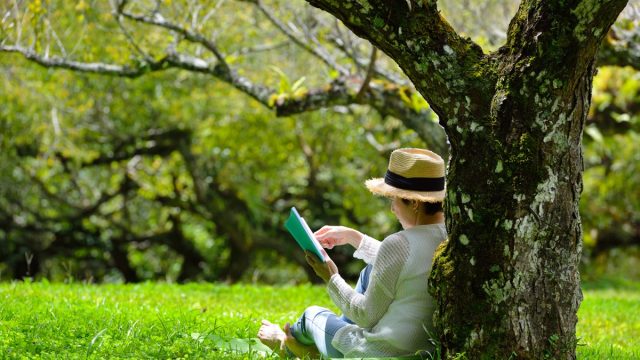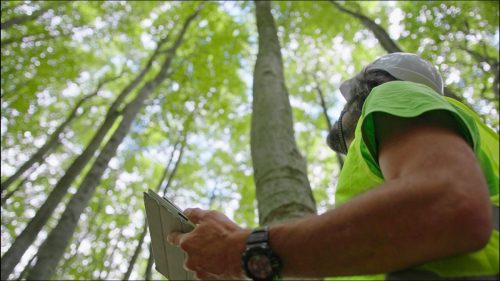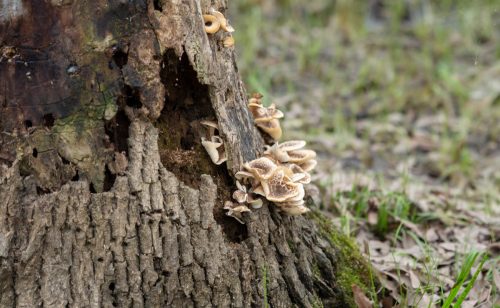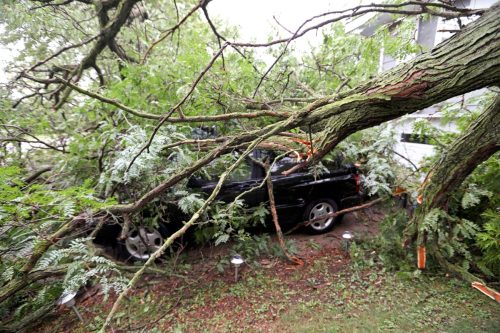Never Sit Under a Tree if You Notice This, Experts Warn

Many of the trees you come across every day have been around far longer than you’ve been alive. When it comes to how many years a tree can live, it really depends on the species, according to the University of California, Santa Barbara (UCSB). Most trees can live anywhere from around 100 years to more than 1,000 years—and in fact, the longest-living tree in the U.S. is the bristle cone pine, which can live up to 5,000 years. But a tree’s potentially long lifespan doesn’t mean there aren’t things that can easily bring it crashing down, like disease and damage, and experts have pinpointed one major warning sign that may indicate a tree could fall at any minute. Read on to find out what you should watch for to avoid putting yourself in danger.
READ THIS NEXT: If You Have This Tree in Your Yard, Kill It and Cut It Down, Experts Warn.
Disease is a major contributor in the death of trees.

Like any other living thing, trees are at risk of being infected by various diseases, according to the University of Arkansas (UA) System’s Division of Agriculture (DOA). For most species, common diseases typically affect one of three major parts of the tree: the foliage, stem, or root. And while some of these diseases are “merely unsightly,” others can actually end up killing the tree.
According to the DOA, stress caused by a number of different environmental factors can place trees at greater risk of disease. “When the defenses against disease are compromised, the disease can gain a foothold in the tree resulting in infection and sometimes in tree death,” the department explains. “Good tree management reduces drought stress and mechanical damage and thus reduces the likelihood of disease problems with trees.”
One noticeable sign likely indicates a tree is infected.

While a tree can survive for quite some time, it might be time to worry if you notice one specific thing: mushrooms growing at its base. Several fungal diseases can decay wood in trees, according to the University of California’s (UC) Integrated Pest Management Program (IPM). And because mushrooms are the fruiting body of a fungus, their presence around the base of a tree is usually an indicator that it is has already started “undergoing a period of decay,” according to Zackary DeAngelis, an outdoor expert and founder of Tree Journey.
“When mushrooms start to grow inside the tree, it’s a death sentence for the tree,” explains Ava Martin, an environmental scientist and founder of Quality Water Lab. “Mushrooms and fungi feed from the tree’s base, taking away all essential nutrients. This weakens the tree’s base and causes it to collapse.”
RELATED: For more up-to-date information, sign up for our daily newsletter.
A tree could fall at any time once mushrooms appear.

The speed at which a tree might fall once it has been infected by a fungal disease depends on how “extensive the decay is,” says Vera Kutsenko, a nature enthusiast and founder of online home garden and lawn marketplace Neverland. According to Kusenko, it usually takes around three to five years for fungus to eat up a tree and cause it to fall. But by the time you see mushrooms growing outside the tree, the fungus has likely already been growing for some time.
“[Mushrooms] often sprout after the fungus has already established itself inside the tree,” naturalist Robert Korpella explained in a written piece for SFGate. “By the time mushrooms form, the internal structure of the tree is usually already compromised.”
Call a professional for help if you notice this problem.

If you notice mushrooms growing at the base of your tree, don’t unnecessarily put yourself in harm’s way—especially since “the tree can fall anytime after the mushrooms have infested it,” says Martin. So if you’re thinking that sitting under a tree with mushrooms around it can’t be that dangerous, think again. “Sitting under a tree that’s about to fall puts your life at risk. It might just fall on top of you, resulting in a severe injury,” Kutsenko warns.
Instead, experts say you should reach out to the professionals. “Until a professional local arborist can come and look at your tree, you shouldn’t do anything with it … you shouldn’t remove a tree by yourself unless you’ve got proper experience doing so,” DeAngelis says. “The arborist will identify the specific variety of tree you have in your yard, tell you if the fungus or mushroom is problematic for the tree, and offer treatment options such as treating the fungi or removing the tree altogether.”